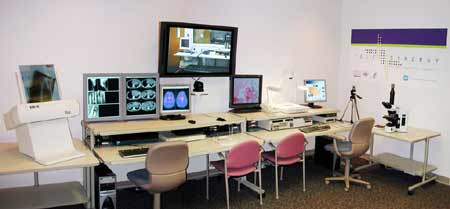![]()
TELESYNERGY® is a fully HIPAA-compliant video conferencing system that provides medical professionals with all of the components necessary to collaborate with one another on cancer research and treatment, regardless of geographical location. The system's multi-imaging capabilities integrate peripheral images into one system to be used together during a video conference where they can be viewed in near-diagnostic quality.
The TELESYNERGY® system is available to hospitals entering into partnership or grantee agreements with the National Institutes of Health. Currently there are over twenty institutions worldwide using the TELESYNERGY® system. Twelve of these have been awarded a five-year TELESYNERGY® grant to help disparate communities with cancer care and treatment, as well as distance learning in cancer research. There are also many institutions both in the United States and internationally who have funded their own TELESYNERGY® systems for use in scientific partnerships with the National Cancer Institute.
With the success of the TELESYNERGY® system and its programs, NCI has made a simplified version of the system available for public purchase by outside institutions (this includes technical consultations, installation, and training). NIH institutes can start their own TELESYNERGY®-based partnerships and programs by working with the Center for Information Technology.
History of TELESYNERGY®
The National Cancer Institute has always believed that technological solutions in healthcare must be dynamic, flexible, and appropriate to the complexities of today’s medical challenges. To achieve this goal, the NCI developed a “virtual integration initiative” by forming strategic collaborations, consultations, and educational programs through off-site research. This is now known as the “Partnerships in Science” initiative.
This initiative is directed towards a seamless integration of cancer care and research, both nationally and internationally. To meet this goal, telecommunications can remove time and location as constraints on organization structure, coordination, and service. It ends the old organizational dichotomy between centralization and decentralization and is often the fastest source of opportunity and innovation. The telecommunications solution for the Partnerships in Science initiative is the TELESYNERGY® Medical Consultation Workstation.
TELESYNERGY® was first developed in the late 1990's at the Center for Information Technology (CIT) in Bethesda, Maryland. The initial application area for TELESYNERGY® was in support of treatment planning in a radiation oncology environment. For example, an oncologist from the NCI Radiation Oncology Branch (ROB) and a colleague at a Partnerships in Science institution could consult during the identification and description of a lesion prior to the development of a radiotherapy treatment plan, during the evaluation of a radiotherapy treatment plan, or during the course of treatment to discuss the patient's progress.
The TELESYNERGY® System has continued to develop and improve in functionality and affordability. TELESYNERGY® is constantly adapting to include new technologies and incorporate the latest medical devices. New versions of the system have been developed to offer institutions different options in cost, size, and functionality. Some additional applications of TELESYNERGY® include general cardiology, all ultrasound, nuclear medicine, otolaryngology, ophthalmology, dermatology, mammography, and histopathology.
These pictures show several different versions of TELESYNERGY®:

The original TELESYNERGY® using NIH developed Unix-based software.

The first generation CDRP TELESYNERGY® system using commercially developed Windows-based software.

The second generation CDRP TELESYNERGY® system using commercially developed Windows-based software.
Today, uses of TELESYNERGY® have increased, and the possibilities have become endless. Medical professionals around the world have been awarded grants to work with under-funded populations to help them receive care they normally wouldn't.
See what some participating institutions are doing with TELESYNERGY®.
If you are interested in licensing TELESYNERGY® for your independent group or organization, contact the NCI TELESYNERGY® Group. NIH scientists and their partner institutions interested in using TELESYNERGY® to support NIH research or those interested in the CIT-Developed TELESYNERGY® software should contact CIT's TELESYNERGY® group.


